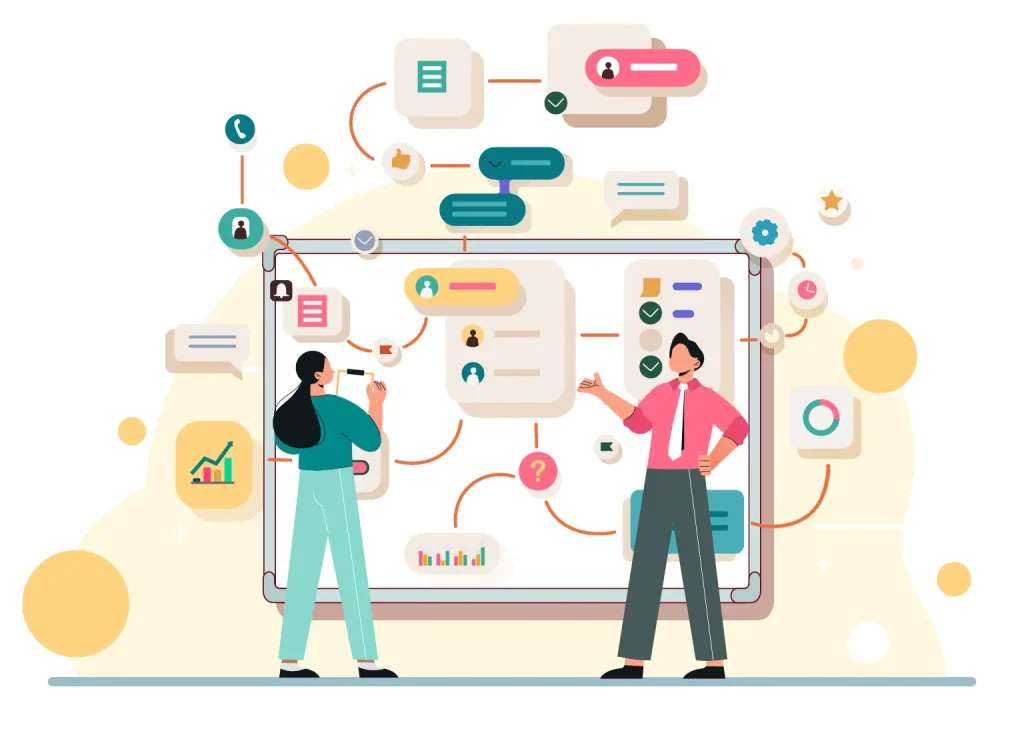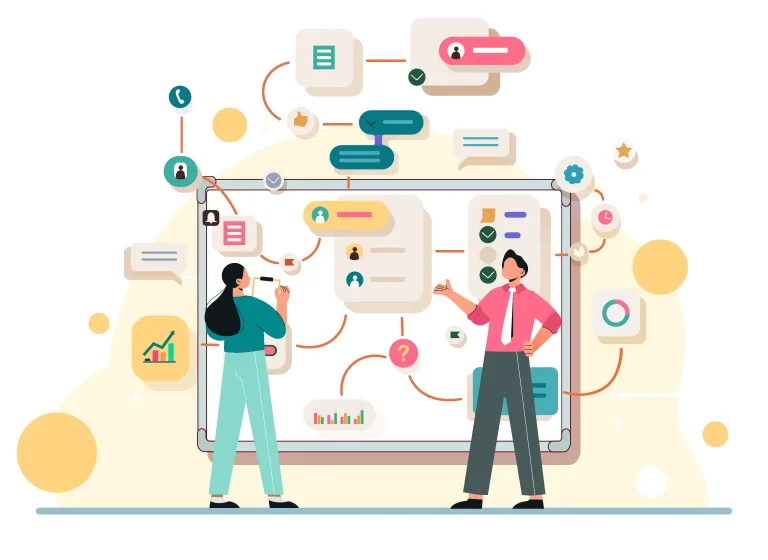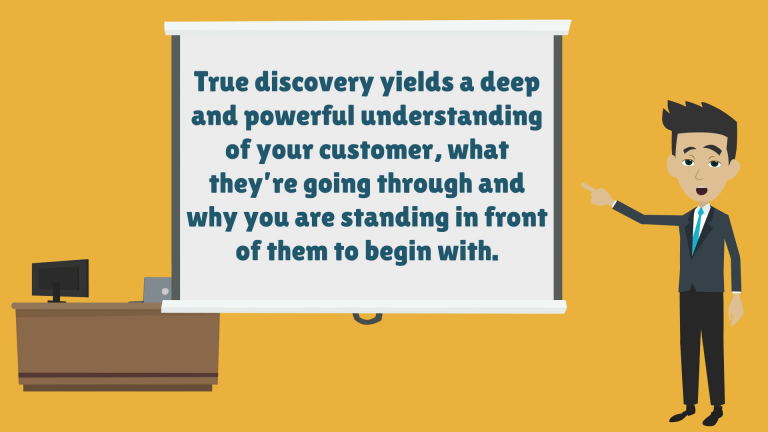Sales training course materials whether video, PowerPoint slides or sales playbooks, are used to support the learning journey of salespeople. Every sales training course, whether online or delivered in classroom, is designed to improve the sales skills and knowledge of salespeople. The training materials used will cover most of the sales process from prospecting, handling inbound leads, value propositions, objection handling, sales conversations, closing the sale, etc.
The important point is that sales training should provide the tools to any salesperson to empower them to have a successful sales career where the company also benefits.

Sales Training Impact
Too Much Training (or Not Enough)
There is a fine line between having too much and too little sales training. If salespeople are required to attend endless training sessions, that seriously cuts into their time to sell. But if they aren’t offered anything at all, they may feel like they are floundering when it comes to the knowledge of the solution portfolio—how to sell it, how to identify the right target audience, and how to differentiate from the competition. Today, sales training programs have to cover more than just hard selling skills; they have to include topics and training on sales mindset, psychology of selling, soft sales skills, communication skills, person branding, and social media channels, among others.
Every salesperson learns at a different pace. Some love reading an e-book or sales training course materials on a specific sales skill; others prefer online sales training with video content to learn in their own time. Others still prefer more traditional classroom learning. Whatever the delivery channel, the outcome is the same: to upskill the salesperson.
The challenges in measuring the impact of sales training on an individual salesperson level may seem hard. However, numerous studies have pinpointed the impact of constant sales training mainly in areas of hitting targets (3–8% improvement), higher success in new custom acquisition (as much as 25% improvement), and improved close rates due to salespeople being skilled at matching customer needs (15% improvement). Maybe these are good starting measures for a salesperson or sales training department to measure over time.
Buyers want value-added conversations.
Buyers are smart; they read articles, source information, and trawl the web for insights without any sales help. What does this mean for a salesperson? It means that they must focus on adding value to the sales conversations. They must have the skill to increase buyer confidence and help the buyer prioritize the information that matters. Today, the most successful salespeople help their buyers simplify the endless amounts of information they are bombarded with, creating confidence and reducing scepticism. This customer-first approach builds a feeling of trust and control with the buyer, helping them with data, facts, or insights to make decisions.

Know the buyer’s mindset.
All of us like or love to buy things. The funny thing is that we don’t like to feel that we are being sold to. What does this mean? The feeling of being sold brings up emotions of being pressured or even manipulated into deciding on something that someone wants us to do. When, as buyers, we feel pressured or backed into a corner, we tend to tune out, disengage, or become angry. The end result is a breakdown in communication and participation in the sales process; we opt out or go cold!. When this happens during sales conversations, salespeople often sense this level of disengagement, but they are unsure what to do about it. Salespeople have to bring value to their buyers, so having a thorough understanding of how buyers think, how they behave, and how they buy is critical to building value in all selling efforts.
Salespeople need to know buyers are usually conflicted about change because buying is a change management project. They identify reasons to change as well as reasons not to change. It is the role of the salesperson to move the dial in favor of change. This is where the magic happens in sales. The degree to which a salesperson motivates the buyer to move beyond the status quo and become active towards change will determine the success (or failure) of selling activities.
The sales mindset.
Selling is a producer’s game. Which means every salesperson has goals or targets to meet. The quickest way to fail in modern selling is to take the human element out of the sales equation. Our buyers are not statistics, data points, dollar signs, or forecast numbers. When the sales team or management is facing challenging situations, there’s something tangible about slicing and dicing the numbers. Analyzing data and forecasts is our comfort zone.
Behind every data point is a story, a real customer with problems to solve or initiatives to implement. By accepting and embracing this concept, salespeople should approach the sales process with a more productive mindset. In other words, the objective shifts from an internal focus on “getting that deal” to an external focus on “helping the customer be successful.” Salespeople become less driven by their own internal goals in favor of helping customers meet theirs. Ask any customer, and they will tell you that this attitude can get their attention, build relationships, and make you a trusted resource (and a top-performing salesperson to boot).
If salespeople adjust their mindsets to incorporate the human component of the sale, they will dig deeper during sales training and answer some additional questions:
• Who is the customer, professionally and personally?
• What role do they play in the organization?
• What initiatives are they personally working on?
• How can I partner with them to help them reach their goals?
• What problems do they need to solve?
• How can I help them be successful now and in the future?
The insights they gain from those human-focused questions during training will give them a real edge in the sales process. Finding that human angle is definitely one of the competitive advantages a salesperson brings to the sale.
Communication Skills.
Effective communication happens when salespeople follow the basic principles of professional communication skills. These can be abbreviated as the 7 Cs, i.e., clear, concise, concrete, correct, coherent, complete, and courteous. Sales training course materials should and must include this key selling skill.
- Clear. Be clear about what you want to say and write.
- Concise. Use simple words and say only what is needed.
- Concrete. Use exact words, phrases, Use facts and figures.
- Correct. Use correct spellings, language, and grammar.
- Coherent. Your words should make sense and be related to the main topic.
- Complete. Your message should have all the needed information.
- Courteous. Be respectful, friendly, and honest.
Effective Communication. If a salesperson can achieve the desired level of outcome through their communication, you can say that it is “effective communication.”. e.g., if your communication gets the desired response from the customer, it means that you effectively conveyed the message.
The sales objection.
Sales objections are not bad at all; in fact, many are signals. All they really mean is that a salesperson has not built up sufficient value in their proposition, and the customer needs to see clear reasons to change. Salespeople need to build value with confidence to get the customer to become active in the process; in other words, “is it worth the hassle?”. There are two ways salespeople can build value. They can either increase the severity of the problem or they can increase the value of the solution. Think of any great team or sportsperson that competes at the highest level. Do they expect competition? Do they expect that winning is easy? Do they prepare for obstacles and different scenarios? Do they think they can just show up?
The answers, of course, are that great teams and sportspeople win because they plan for challenges and prepare in advance to overcome them. The same principles are true in sales objections and selling.
There are three characteristics of buyer behavior that drive objections that salespeople should be aware of.
- To avoid conflict internally or with an existing solution or vendor,.
- Hesitant with change as buying poses a change management project.
- Adverse to risk both to their role, status and systems.
Storytelling.
Storytelling is ‘data with a soul. Stories are not nice to have but are critical for our happiness because they provide unity, purpose, and meaning. Because telling a compelling story is not about a 20-minute TED talk. It might be the salespersons 30-second introduction to a meeting, the three-minute update, the snatched conversation in a corridor, the job interview… In fact, it’s every time any of us open our mouths to try to persuade anyone of anything. And the key to unforgettable communication is storytelling.
Protip: Always speak in short, sharp sentences with a clear tone. It’s very common for salespeople to speak slowly or too fast when communicating, which indicates insecurity or brushing over something. This raises doubts in the subconscious of the buyer. Slowing down or rapid-fire sentences are not the answer. The key is to speak in short, sharp sentences and to pause after each sentence while keeping appropriate eye contact.
Master the sales process.
The sales process is a series of sequences and value-added communication which opens the way towards a predetermined goal, which is a sale. Almost every business has or should have their own sales process, which tells salespeople how to undertake their sales activity.
Acquiring, developing and maintaining customers involves using a variety of marketing, sales and support steps with the goal of converting prospective customers and retaining paying ones. The sales process is usually illustrated as a funnel or map, which consists of several steps that keep the sales moving forward. Each step will have a commitment marker to ensure continued engagement is worthwhile.
The main benefit of having and following a sales process is that the salesperson or business can monitor and measure the commitments or outcome in each step. This enables everyone to use the sales training to focus on developing better results at each stage of the process, thereby improving sales and consistency.
‘Success is a process more than a realisation.’
The basic sales process in sales training course materials consists of seven steps: prospecting and qualifying, pre-approach, approach, presentation and demonstration, handling objections, closing, and follow-up. Running alongside all the steps in the sale is the need to establish and build trust, credibility, and proof. The fact is that salespeople need to demonstrate these at every step of the sales process.
Authentic listening.
Authentic listening requires salespeople to master concentration, curiosity, and clarity. Without some form of listening, active or authentic, it’s easy to twist the meaning of messages so that the original intent is lost completely. It’s no wonder that more salespeople aren’t better listeners. Authentic listening first requires hearing the message. We have many sensory channels with which to take in a message. Concentration focuses not only on paying attention but also on who we are listening to. Is it one-on-one or in a group setting? Are you listening to distracting internal chatter or external distractions that make it difficult to absorb the message?
The essence of authentic listening is a deep curiosity to meaningfully connect with another person—to really get to know someone else.
Choosing sales training course materials
Most sales training materials will include content on topics such as call handling, presentation skills, building relationships, qualifying leads, understanding customer needs and pain points, networking, communication, objection handling, negotiation techniques, and closing sales. Other important elements of sales training may include the hard sales skills of understanding the product or service being sold. While soft selling skills should also be included in sales mindset, empathy, body language, etc
When it comes to planning out sales training course materials, it should be remembered that the investment of training salespeople to better engage with customers or prospects is today a key differentiator. Salespeople want to work for organizations that provide professional development to improve their selling and business skills. In fact, recent research shows many consider it a deciding factor when looking for new employment or determining if they should stay with their current sales position. We know that learning and development in employees play a critical role in engaging and retaining the best talent.
One way companies are addressing their sales training programs is to position them as an employee incentive. They outline the programs available both offline and online, then add them to their existing benefits package alongside other benefits such as retirement and health and wellness programs.
Micro-learning sales training
The use of video-based micro-learning is growing rapidly because, as humans we absorb information more efficiently when it is broken into small pieces, think YouTube or TikTok. Video based learning works great for developing a broad range of sales skills whether that is the hard selling skills or the softer skills such as communication or empathy. Micro learning works because it shows the salesperson in easily digestible lessons what they are supposed to do in any given situation. The salesperson can then replicate what is shown in the video to quickly learn or relearn a sales skill.
This method of sales training ideas gives the sales team 24/7 access to lessons and content. This allows them to watch a video before using the skill, re-watch the video after actually using it in a sales conversation or even apply the sales skill on the fly as the video plays on their screen.
This makes video-based sales skills learning perfect for “Always On Learning”.
Micro-learning is the future of remote sales training. Selling today is already complicated enough. Learning new sales skills should be simple.
Match your sales process to sales training.
Choosing a sales training program or a series of sales training course materials that’s right for your company depends entirely on your sales process. Your sales process is the customer-facing side of your business. Everything leading up to (and resulting in) a sale is considered part of the process. Effective training is not a one-and-done proposition. Your sales team needs ongoing support that helps them hone their skills and deepen their knowledge.
How to maximize sales training ROI.
All sales training online or offline needs to be accessible, impactful, and based on the real-life scenarios any salesperson will encounter. Keeping training topics short and concise is the best way to help salespeople learn the crucial skills they need to succeed. Training that works to their schedule, where they can dip in and out of sales lessons as needed. A sales training course that does not take up too much of their time yet upskills them across a whole range of selling skills that the modern buyer expects.
When sales training is deployed and correctly utilized then the organization should expect the following outcomes:
Consistent sales habit loop. The sales team understand and follow the documented sales process including assets, procedures, and sales playbook.
Drives sales performance: Salespeople embrace implementing the new sales skills learned, and their mindset changes to perform at a higher level.
Improved sales ownership: As the selling skills become second nature, it allows the salespeople to be more productive; to own their roles, customers see more value in engaging with them and so sales go up.
Sales training costs go down: Online sales training programs can be one channel to ensure training costs go down and sales time goes up.



